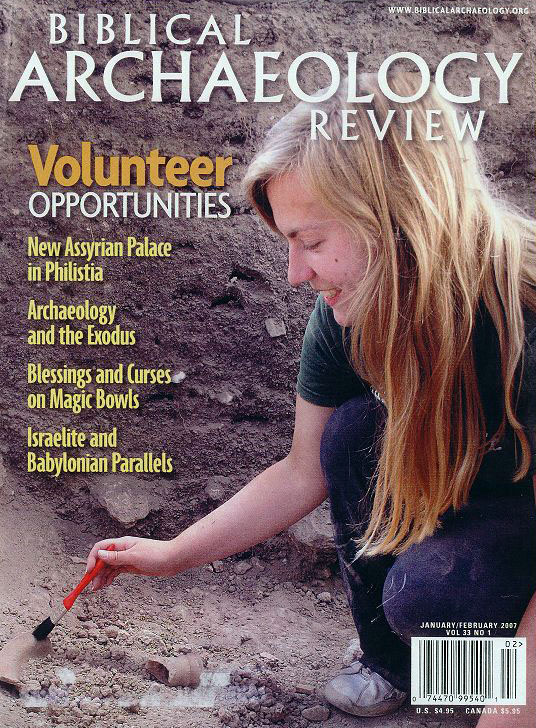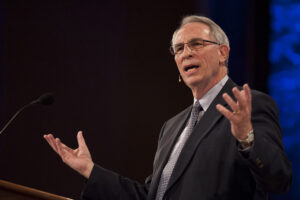
FORT WORTH, Texas (BP)–A major biblical archaeology magazine has highlighted Tel Gezer, an archaeological dig now sponsored by Southwestern Baptist Theological Seminary and the Israel Antiquities Authority, on the cover of its January-February issue.
The Biblical Archaeology Review’s cover features a photo of a Baptist collegiate volunteer unearthing fragments of a chalice discovered at Tel Gezer. Steven Ortiz, co-director of the Tel Gezer dig and associate professor of archaeology and biblical backgrounds at Southwestern, submitted the photo taken by Gary Arbino, associate professor of archaeology and Old Testament at Golden Gate Baptist Theological Seminary in California.
“Biblical Archaeology Review is the premier archaeology magazine for reporting developments in the field in a way that is accessible to laypeople,” Ortiz said. “Scholars, Sunday School teachers, pastors and rabbis read it. For a photo from Tel Gezer to appear on the cover heightens attention to the project as it goes into Southwestern Seminary’s inaugural season this summer.”
Inside the Biblical Archaeological Review issue, the dig at Tel Gezer is among 19 digs listed with contact information for volunteers at BAR’s “special digs Web site”: www.findadig.com.
The website identifies Tel Gezer as “one of the most important sites in the northern Shephelah region of Israel.” The Shephelah is a region of low hills in Israel that runs north and south, settled between a coastal plain on its west and Israel’s central mountain range on its east.
“Gezer is a famous site in the Bible and in the discipline of biblical archaeology,” Ortiz said. “It was a natural choice for editors of Biblical Archaeology Review to use our project to highlight archaeology projects in the Middle East for the 2007 summer season.”
The 2007 dig at Tel Gezer, which will take place June 18-July 20, is Southwestern’s first year to co-sponsor the project alongside the Israel Antiquities Authority as part of the seminary’s revitalization of its archaeological program after 15 years of dormancy. It is also the second year of excavations that have been renewed at Gezer after 30 years of inactivity.
During last year’s dig season at Gezer, workers led by Ortiz and Sam Wolff of the Israel Antiquities Authority uncovered a large fortification system associated with the time of King Solomon along with two layers of destruction tentatively dated to the reigns of the pharaohs Merneptah and Siamun. Many scholars identify Siamun as the pharaoh who, according to 1 Kings 9, captured the city of Gezer and gave it to his daughter as a dowry when she married King Solomon. The Israelite king then fortified the city.
This summer’s dig at Tel Gezer will emphasize Iron Age remains running along the southeastern slope of the site’s western hill.
In February, Southwestern will host Gabriel Barkay, one of today’s foremost biblical archaeologists, when he visits north Texas as part of a national speaking tour.
Barkay, professor of archaeology at Bar Ilan University near Tel Aviv, will present a lecture at Southwestern on Feb. 5 at 7 p.m. on the oldest fragments of the Bible ever found, which Barkay uncovered during an excavation in Jerusalem in 1979. He will then lecture at Criswell College and Dallas Theological Seminary on Feb 6-7, where he will discuss his archaeological work associated with the Temple Mount.
Born in Hungary, Barkay moved to Jerusalem early in life and later earned a doctoral degree in archaeology at Tel Aviv University. It was while doing research for his dissertation that Barkay discovered the oldest engravings of Old Testament Scripture yet to be found in the Near East.
In late 2004, Barkay began the process of systematically excavating soil that had been removed from the Temple Mount and dumped into the Kidron Valley. The work already has revealed many coins from the second century B.C. to the 19th century A.D.
–30–
For more information on Tel Gezer or the summer 2007 excavations at the dig, contact Steven Ortiz at [email protected] or check out the projects website: www.gezerproject.org.
















